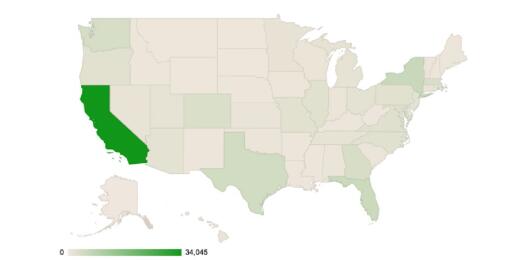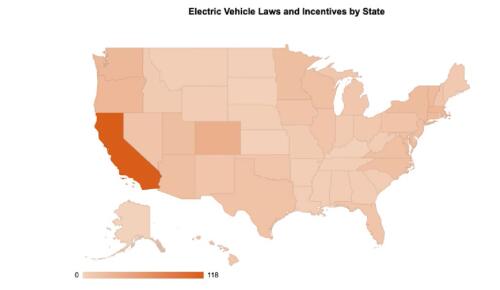Electric Vehicle Limbo: the Need for Charging Incentives
| Publication year | 2021 |
Electric Vehicle Limbo: The Need for Charging Incentives
Shahil Patel
A study published by AAA in 2018 shows, "20 percent or 50 million Americans, will likely go electric for their next vehicle purchase."1 This means that 1/5 Americans plan on moving on from their previous gasoline car to an electric vehicle. Fast forward to 2021, electric vehicle technology has vastly improved in the battery, range, and charging spheres which further popularizes this movement. It is evident that companies have taken note, as announcements of new electric vehicles coming to the market keeps increasing. There are many reasons for this shift and electric vehicles are set to become the future.
Ironically, electric vehicles were some of the first vehicles invented as early as the 1800s.2 In the early 1900s these vehicles were more popular than gasoline powered cars due to their many advantages over gas cars.3 However, electrical vehicle technology was stalled as gasoline powered cars began using an electric starter that took away the need for manually starting the vehicle.4 Nevertheless, these electric vehicles have started to make a comeback as the technology is rapidly expanding. One of the reasons for this movement has been powered by the realization of the impacts of gasoline powered cars on the environment.
However, there are obstacles that must be overcome for electric vehicles to take over the road. Generally, two main concerns for consumers are running out of charge while driving and the poor electric vehicle charging infrastructure in the united States.5 on the other hand, there are not that many electric vehicle charging incentives for businesses like gas stations to warrant such a major investment.
Summarized, consumers do not want to buy electric vehicles without a better charging infrastructure and businesses do not have enough incentives to build that better charging infrastructure—hence, the electric vehicle "limbo". This highlights the need to start developing the EV charging infrastructure now rather
[Page 76]
than later. To get out of this limbo, the federal government needs to further incentivize electric vehicle charging stations for gas stations.
The trend in the car industry is heading towards battery electric vehicles ("EVs") that run on electricity. This trend is evident by the abundance of automakers like Audi, BMW, Ford, GM, Jaguar, Lucid Air, Mazda, Mercedes Benz, Nissan, Porsche, Tesla and many others that are looking to produce these cars.6 Electric cars function by taking power from a grid when plugged in and storing electric energy into rechargeable batteries which power the motor.7
The three main types of electric vehicles are plug-in electric ("PEV" or purely electric), plug-in hybrid (mainly electric but also fuel powered), and hybrid-electric (mainly fuel powered and some electric).8 A big advantage for EVs comes through regenerative braking, "in a traditional car, the kinetic energy caused usually goes to waste. However, in an electric car braking converts and stores thermal energy from brake pads and tyres' heat friction and reuses it to power the car."9 The main internal parts of a pure EV are the electric motor, inverter, drivetrain, batteries, and charging port which amount to 90% less moving parts than Internal Combustion Engine Vehicles ("ICE").10 Due to this, the ride of an electric car is more quiet and smooth.
The most common cars you see on the road today are ICE cars which are powered by fuel. ICE car engines are made up of cylinders and pistons. These cars inject a mixture of fuel/oxygen into the engine and a spark ignites the fuel to make combustions that drive the crankshaft.11 This energy is turned into rotational energy that allows movement of the vehicle.12
One of the biggest advantages of ICE vehicles are that gas stations are abundant. This means you can practically drive as far as you like as long as you fuel your vehicle. On the other hand, the same is not true for EVs that require
[Page 77]
charging stations that are not so plentiful. However, the biggest critique of ICE cars is the maintenance and the reliance on gasoline—a fossil fuel. The environmental impact of ICE vehicles is fueling the movement towards EVs.
A. Electric Charging Stations and Companies
Every EV needs the electricity to come from a charging station. There are three different levels of charging stations currently: Level 1, Level 2, and Level 3.13 Level 1 chargers are the slowest and can be used with a standard 120-volt AC plug that you use for common items around the house.14 According to the U.S. Dept of Energy's Alternative Fuels Data Center, "...8 hours of charging at 120 V can replenish about 40 miles of electric range for a mid-size PEV. As of 2020, less than 5% of public charging outlets in the United States were Level 1."15
Level 2 charging is the most popular which is installed in most residential and public charging stations making up about 80% of public outlets.16 These chargers provide 240 V and are usually relied upon to have EVs charged overnight at home or during work.17
Level 3 chargers are more commonly known as direct current fast chargers ("DC fast chargers") because of their rapid charging which are 400 V or more.18 The Alternative Fuels Data Center reports, "as of 2020, over 15% of charging outlets in the United States were DC fast chargers. There are three types of DC fast charging systems, depending on the type of charge port on the vehicle: SAE Combined Charging System (CCS), CHAdeMO, or Tesla."19 Tesla has its own network of DC fast chargers which they have termed Superchargers but their cars come with adapters to allow for the use of other types of chargers.20 DC chargers can charge 80% of capacity in around 20-30 minutes21 and this technology only seems to be getting better. EV charging is more effective when
[Page 78]
stopping the charge at a DC fast charger at about 80% because the charging slows down dramatically after that.22
There are many different private companies, local governments, and public-private partnerships for these charging stations.23 Other than Tesla, whose superchargers are only available to Tesla drivers, the three largest networks belong to ChargePoint, Electrify America, and EVgo.24 Many consumers download apps such as ChargeHub, PlugShare, and OpenCharge Map to see all of the EV chargers near them or on their route.25 Some apps even show you if the chargers are available at the moment or in use which makes the process a whole lot easier.26
B. Graphs and Data
1. Charging Stations and Charging Outlets in the US

Figure 1: The number of public EV charging stations/outlets in the US as of March 3, 2020.27
[Page 79]
According to Statista, EV sales improved from around 115,000 in 2015 to 358,000 in 2018 because of the rise in the number of plug-in power stations and charging outlets.28 Statista claims, "With faster charging and cheaper, more efficient batteries, long distance travel becomes possible with plug-in EVs."29 Due to this, California EV fleet size is expected to grow to four million by 2030.30 To make EVs more popular, expanding the charging station/outlet network is vital for the rest of the United States.

Figure 2: EV charging outlets by state.31
[Page 80]

Figure 3: Incentives for EVs in the United States ranging from 0-118 laws and regulations.32
Correlation does not necessarily mean causation. However, comparing Figures 2 and 3, it seems that there could be a relationship between incentives for EVs in a state and the amount of charging outlets. This comparison alludes to the fact that more incentives equal more charging outlets. If this were true, this shows how important government incentivization is to expanding an EV charging infrastructure.

Figure 4: Volvo study shows EV charging location frequency in 2019.33
[Page 81]
This 2019 study by Volvo shows that a majority of their EV's charging is done at home. There is an argument to be made that most EV charging happens at the home rather than at a public charger so why incentivize gas stations. Although this might be true now, this notion can be very misguided when looking towards the future. As of right now, the average cost of an EV in the U.S. is about $55,600 whereas the average cost of a new car is around $36,600.34
Because the average cost of a new EV is about $20,000 more than a new car, more affluent people could be buying EVs. A study performed by CarMax in 2017 reports that 70% of EV owners make over $75,000 per year.35 Coincidentally, according to Statista, the average income of a homeowner in 2017 was $75,000.36 This could mean that these more affluent people that are buying EVs right now have houses where level 2 EV chargers can be installed. However, as companies continue to focus on making EVs less expensive, a greater amount of Americans without houses will become buyers. This means all of these new EV drivers without houses would need places to charge their EVs—enter gas stations.
C. Cost of EV Charging - Tesla
EVs have a vast range of cost depending on model, location, and how much a consumer drives. Ultimately the costs vary depending on charging at charging stations versus home. At home costs also depend on your utility company. Because Tesla cars are the most popular EVs, it might help to use these as an example.
In the United States, the national average cost for power is 13 cents per kilowatt-hour ("kWh") with an 85% charging efficiency for level 2 home chargers.37 Based on these numbers, a Tesla Model X would take around $15.29 for a full charge at 5 cents per mile providing 305 miles of driving range.38 Whereas, the less expensive Tesla Model 3 would be fully charged at $7.65 at $0.03 cents per mile.39
[Page 82]
According to SolarReviews, "this is almost 64% less than the cost per mile to drive the most popular gas-powered cars...
To continue reading
Request your trial
